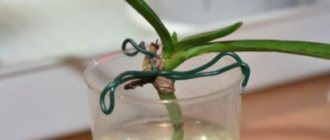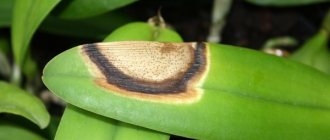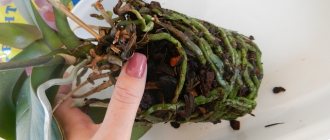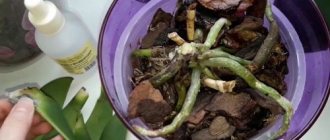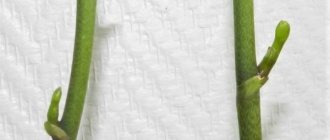Features of the root system
Orchid aerial roots are roots that grow outside of the potting medium. They can grow from stem nodes at the top of the stem or emerge from potting soil. Some orchids produce many aerial roots, while others have few or no roots.
Orchids are natural epiphytic plants. This means they grow on other plants rather than in soil. Roots are responsible for anchoring the plant in place of growth, as well as for absorbing necessary water and nutrients.
Aerial roots are not that rare. But if you are new to growing phalaenopsis orchids, this term may not be familiar to you. The appearance of roots above the surface of the pot does not mean that the orchid has become cramped in the pot and needs to be replanted - just air outlets have begun to grow in the plant.
Also find out what to do if the peduncle of an orchid has dried up.
Structure
The structure of phalaenopsis aerial roots is very different from the structure of ordinary roots of land plants. The spongy tissue velamen covers the inner filamentous part of the root with a thick layer of epidermal cells. Velamen helps orchids cling to tree branches, absorb water and nitrogen from the air , protects them from damage and retains moisture, thereby providing water to the entire plant and protecting it from drying out.
Aerial roots are natural to epiphytic species that grow on other plants in tropical forests. Unlike terrestrial orchids, which root in the ground, epiphytic species naturally grow above ground, using their roots to attach themselves to tree branches and reach brighter areas among the foliage.
Unlike other plants that attach themselves to trees, phalaenopsis orchids are not parasitic or invasive. Epiphytes, with a unique root system, use their roots to absorb nutrients, moisture and carbon dioxide to grow and survive directly from the air, without feeding on tree sap .
We recommend reading how to propagate an orchid from cuttings at home.
Appearance
Although aerial roots do not improve the aesthetic appearance of the flower, nothing needs to be done with them - this is the natural development of the plant. They are cylindrical or flat in shape and should be firm to the touch.
The aerial roots become bright green immediately after watering, which is a sign of healthy roots. As they dry, they first turn silver and then gray or whitish, which means that the orchid may need watering . Just soak the roots for 2 minutes or spray them with water and they will turn green again.
Drying of air appendages
Identifying the cause
The appearance of roots in the aerial parts of orchids is a natural process , since they are part of the nutrition system. Their condition determines the development of the epiphyte: health, energy, strength, frequency and duration of flowering.
Damage or deterioration of the air appendages threatens to dry them out, which can lead to the complete death of the exotic pet. The manifestation of problems in the above-ground food system requires immediate action.
Healthy aerial roots can be distinguished by the following characteristics:
- quite dense to the touch;
- fleshy texture;
- the surface is smooth;
- tight when pressed;
- have a silver-green or shades thereof color.
Wrinkling, oiliness, loss of density, dark spots or dark color require immediate action from the owner.
What to do?
If the aerial roots are dry, first of all it is necessary to find out the cause of this condition and try to eliminate it immediately. If the situation has not gone too deep, then you can get by with a single pruning of the damaged roots. If the condition is sufficiently neglected, a transplant should be carried out urgently, following the instructions of experienced orchid growers.
If the roots are severely damaged, the orchid should be urgently replanted.
The reason for the appearance of aerial roots
The growth of a plant and its root system is a natural cycle of development and renewal, so the appearance of new roots more often indicates the healthy and proper development of the orchid . The appearance of 2-3 aerial roots is normal and should not cause concern.
But sometimes the reason for the intensive growth of aerial roots above the potting substrate can be excessive moisture or increased dryness and too warm air (for example, when located next to a heating radiator) - growing out of the pot, the flower tries to find a more comfortable place.
Read more about how to care for orchid roots.
Choosing the right filler
There is another reason why the roots grow outward; it is associated with the use of the wrong filler. Only a special substrate is suitable for growing orchids, which can be purchased ready-made at a gardening store. You can create it yourself from soil, moss and bark.
When growing flowers in ordinary soil, unfavorable conditions will be created for them, which will make it impossible for them to develop a dense root system, so aerial shoots may begin to appear within a few months after planting.
How are they different from regular ones?
Aerial roots are similar in many ways to normal roots growing in a substrate—it's just a different root arrangement. They are slightly thicker and are the healthiest on the plant, as they grow in conditions close to the flower's natural habitat.
Household orchids are usually grown in a soilless mixture based on pine bark or sphagnum moss to mimic natural growing conditions in trees . Over time, this potting mix breaks down and requires replacement, and the internal roots are at high risk of developing root rot and fungal infections.
The orchid seeks new sources of nutrients, light and moisture, so its roots twist and turn in all directions, but most of them remain in the drainage pot. If the orchid does not have above-ground roots, then most likely when they appear, they are rooted in the substrate
How to distinguish healthy parts from diseased ones?
They differ in color or feel. Healthy roots are covered with a special spongy substance (velamen) and have a cylindrical shape.
Color can range from silvery white to green . If the roots are brown and break off easily, it means they are dry from lack of moisture, and if you find dark spots on them, this is rot.
Due to lack of lighting, orchid roots turn yellow. A healthy root, if squeezed, remains dense and elastic. If it is pressed through with your fingers and mucus appears, this indicates a serious illness.
Video about the differences between healthy roots and rotten ones:
Why does an orchid need aerial roots?
The health of an orchid depends on the condition of its root system. Aerial roots actively participate in photosynthesis and serve to replenish moisture reserves and further use it.
Functions of air roots:
- fastening and support - epiphytes have completely abandoned underground roots and use aerial roots to anchor themselves on tree branches;
- absorbing water from the environment and storing it for use in drier conditions;
- obtaining nutrients from water, air and symbiosis with fungi (mycorrhiza);
- photosynthesis - similar to leaves, they convert light energy into carbohydrates necessary for plant growth.
Did you know? Orchids, known as lithophytes, use a similar anchoring strategy to epiphytic species, but are anchored on rocks rather than trees.
Resuscitation in the absence of underground roots
If only aerial roots remain, and the lower part of the plant has been fully processed after removing the putrefactive foci, has dried out sufficiently, but there are no roots on it, then there is the option of planting in a new container with some of the aerial roots buried . Particularly long roots should not be buried in the substrate, leaving them at the top to receive nutrition from the atmospheric air.
An orchid is a rather capricious, but very life-loving plant. While the underground part is being revived, the above-ground part will provide and support the life of the plant, receiving what it needs through atmospheric air. And since many types of orchids can be propagated by divisions of aerial roots, even after rooting there is a chance that 4 out of 5 such plants will take root.
Important! When rooting orchids, the main thing is to observe the sequence and correctness of resuscitation measures.
The orchid has many above-ground roots
Sometimes a large number of above-ground roots indicates the need to transplant the flower into a larger pot.
Orchids generally like to be root-bound to the substrate, just like a tree in its natural environment, so most of the root system remains in the pot. However, as the plant grows, the potting medium becomes so clogged with roots that they become crowded and grow outward. In such cases, you should consider replanting the plant.
Root restoration methods
Dead roots are completely removed down to living tissue with a sharp instrument, carefully observing that there are no lesions left on the sections, then sprinkled with cinnamon powder or wood ash (you can grind an activated carbon tablet). You cannot wet the wounds; they must dry out. It is better to refrain from watering for several days.
The root system of the phalaenopsis orchid is different from the root systems of most indoor plants. Some of the roots are located above the pot - these are the aerial roots of the orchid, which raise many questions among gardeners.
Is it possible to trim and when to do it?
A flower's aerial roots should not be pruned because they are a living part of the system the plant uses to absorb nutrients and water. Trimming aerial roots can cause the plant to become sick or even die due to disease or inability to absorb enough elements to grow.
Important! Any unhealthy roots should be removed to healthy tissue using sterile instruments (wipe with alcohol or heated over fire), and the cut areas should be dried and treated with activated carbon or cinnamon powder.
There are several ways to control aerial roots:
- double pot - the main container with the substrate is placed in a decorative pot, which hides part of the air outlets;
- replanting the orchid into a large container with deepening the roots that have crawled out of the potting mixture beyond its boundaries. At the same time, you should not bury the aerial roots growing on the stem.
Only diseased, dry, dead and damaged parts of the roots should be removed. Trimming is carried out until healthy and clean tissue
Review
Lopatin Sergey Alexandrovich (Gigant village, Salsky district, Rostov region)
At first, the aerial roots that appeared in abundance in my flowers seemed like a global problem to me. Since I have been working with orchids not so long ago, I mistook the overgrown shoots for some kind of strange disease. It turned out everything was simple, my flowers stood on the windowsill, under which an old cast-iron radiator was located closely. As a result, the window sill tree, and with it the soil in the pots, became very overheated. The flowers were hot. It was impossible to move the flower pots to another place; my rooms are very dark. I came up with a bench - a stand, which I placed under the orchids. I started spraying them more often. The situation has returned to normal.
Problems and their possible solutions
The aerial roots of epiphytes do not require special care - they will also be healthy if you take good care of the flower itself. However, they may experience the same problems as the stems and roots inside the pot.
Why do orchid roots dry out?
If the roots are gray, dry and wrinkled, or there are no growing tips on them, then the orchid is not receiving enough moisture. This may occur due to the coarse fraction of the potting mixture, which does not allow the roots to better contact the substrate when watering.
We recommend reading how to revive an orchid if its roots dry out.
Low air humidity in the room, which often occurs during the heating season, is also the cause of dry roots - you can place a container of water near the plant and spray it regularly. Try to keep the humidity above 40% to prevent the aerial roots from drying out too quickly.
The roots can also dry out when exposed to direct sunlight, especially at midday - try shading the orchid with a transparent curtain or moving it away from the window
Why does the root system rot?
When roots begin to rot, they become brown and soft and cannot properly absorb water and nutrients. The only thing you need to do to help the plant is to trim the rotten roots back to healthy tissue.
Important! Sometimes the roots turn brown due to hard water and salt deposits on their surface. But unlike rot, salt stains are hard and similar to rust.
The causes of rot can be excessive watering and stagnation of water in the substrate, as well as high concentrations of fertilizers and incorrect temperature conditions.
Only aerial roots remain
If for some reason the flower has only aerial roots left, then the following planting option will help the plant recover:
- cut off all problem roots at the base and sprinkle the sections with cinnamon or activated carbon. Dry the orchid in the air for 3–5 hours so that the wounds from the cuts heal and dry;
- prepare a pot according to the volume of the root system with holes for draining water and ventilation;
- use a fine fraction of bark as a substrate, and lay a layer of sphagnum (1 cm) on top, after dousing it with boiling water;
- give the flower a reliable support so that it does not wobble or tip over in the pot, injuring the roots. Place the root collar at the very surface of the substrate - all parts of the orchid should be in the air and not touch the water;
- leave aerial roots on the surface;
- water not by submersion, but by generously spraying sphagnum moss to stimulate root growth down to the moist surface.
Important! The orchid is very tenacious and can survive by using aerial roots.
Moldiness
Mold on a plant can appear due to decomposition of the potting mixture, excessive humidity and high temperature, which leads to the pot fogging and condensation. In such cases, it is necessary to change the conditions of keeping the orchid and dry the substrate.
Mold is sometimes caused by fungal microorganisms, and here you will need to replant the flower with replacement of the mixture and treatment with fungicides
Aerial roots turn black
Blackening of the roots can occur for the following reasons:
- the plant was exposed to direct sunlight for a long time and received burns. Such blackening is also possible on the leaves;
- long-term decrease in temperature (+4...+6°C) with high air humidity;
- watering or spraying with cold water;
- increased concentrations of fertilizers (only a quarter of the specified norm of flower fertilizers is required);
- deposition of salts in the substrate when watering with hard water;
- pathogenic diseases.
Find out what to do - the orchid's leaves are falling.
What if there are a lot of roots?
The number of aerial roots in an exotic beauty is normally from 2 to 5.
What are the reasons?
- Air .
If there are too many roots, this means that the air is too dry for the orchid. When this exotic is hot, it will try to get more moisture from the atmosphere with the help of its roots. To stop the process, you need to move the flower to a place with more humid air or create an artificial environment more comfortable for the plant. To create natural moisture, you can cover the growing roots with moss. - Substrate . If the components are chosen incorrectly, the orchid will compensate for the lack of nutrients by taking them from the air. Other possible problems with the contents of the pot are the salinity of the substrate, its fraction being too fine, and compaction of the soil.
- Problems with the underground part . They can be very different - from excessive dryness to diseases and pests. Whatever happens to the roots inside the pot, what happens will cause aerial roots to grow as the plant strives to survive.
- Temperature . Overheating occurs when the orchid stands in the sun or above a radiator.
Is it possible to delete?
Healthy aerial roots cannot be removed . This will be a trauma for the flower, due to which it may delay flowering and slow down its growth. If you cut off too many roots, the orchid may die completely, being left without food.
You can only remove dried or diseased roots, cutting them off entirely or partially depending on the condition. Don't forget to disinfect the cuts with activated carbon.
Plant care
Caring for orchids is simple and does not require much effort - just learn the basics:
- Most epiphytes require moist and well-drained mixtures . There are several types of nutrient media that can be used for plants - fir or pine bark, sphagnum peat, stones, cork, charcoal, sand. The fraction of the bark depends on the type of orchid being grown - the coarse fraction is suitable for phalaenopsis, but the plant should not be buried.
- The best location would be windows facing east or south - the plants in question prefer diffused, indirect bright light . Lack of lighting leads to poor flowering, and direct rays at midday can cause leaf burn.
- Temperature and humidity are also important for indoor orchids. A temperature of +18°...+25°C and a humidity of 60% throughout the growing season are considered comfortable, but for the plant to bloom, the night temperature must be 8–15°C lower than the daytime temperature.
- The flower is watered by immersion once every 10–14 days. This is the only case when the epiphyte roots remain in water, but for no more than 3–5 hours. It is advisable to use soft or boiled water, with a temperature of about +30...+35°C. The flower should dry well between waterings.
- During the growing season and plant growth, use a weak solution of houseplant fertilizer every time you water it. No fertilizing is carried out during flowering .
- The flower is replanted every 2 years with a complete replacement of the substrate.
- It is necessary to carefully monitor the plants in order to promptly notice signs of disease or pest damage and take action.
- At home, the phalaenopsis orchid reproduces by children , which grow on peduncles or stems. Propagation by seed or tissue culture is best left to commercial growers as it requires special laboratory equipment.
How to properly care for the root system
To understand that everything is fine with your green friend, often pay attention to its root system, because it is the main indicator that the plant has enough all the necessary nutrients.
The main condition that will ensure full functioning of exotic plants is proper watering. In no case should you over-water the roots of orchids; watering should be judiciously alternated with the drying stage. The thing is that the root system of the flower is in a constant process of photosynthesis, which is why it is most often sold in plastic pots. The transparent surface helps determine whether watering is necessary. If the orchid's roots feel the need for additional moisture, they acquire a rich, light gray color. This shade is given to them by velamen - dead, porous cells that make up the top layer.
It is best to water your tropical guest by immersing the pot in a large container of water, which should be at room temperature and not too hard. Water procedures are also recommended before the fertilization process. Purified, warm water can effectively protect the orchid’s root system from possible chemical burns.
If the roots of the exotic plant have a rich, emerald color, there is no need to rush with watering. A bright green color indicates that the plant still contains moisture necessary for life, and its excess can lead to rotting and death of the plant.
Do not try to transplant the flower into a pot made of ceramics. This material has a detrimental effect on the roots of the orchid, promotes their hypothermia and significantly slows down the process of photosynthesis. If you care about the aesthetic side of the issue, purchase a voluminous ceramic pot and place a plastic container with a green friend in it.
Orchid transplant
Repotting is necessary to ensure good health and optimal growth of the plant. If an orchid remains in the same pot for a long time, the flower will begin to weaken and fade. Over time, the substrate decomposes and becomes compacted, its air permeability is impaired, and the plant lacks air, which will increase the risk of disease and lead to stress.
The frequency of repotting depends on the type of orchid and the type of potting mix. An orchid must be replanted regularly, and phalaenopsis only benefit from frequent replanting. Be sure to use new potting mix when doing this. A composition made from crushed coconut shells will last longer than a mixture of fir or pine bark.
Did you know? Vanilla is the most famous and widely used spice and is obtained from the only commercially grown orchid.
Some experienced gardeners believe that using a mixture of perlite and peat in the potting mix produces fewer aerial roots than pine bark. In any case, when replanting, do not deepen the aerial roots, because they may rot. The new pot for the plant should be transparent and have drainage holes to drain water so that the orchid's roots are not in the water.
An orchid transplant is necessary in the following cases:
- a recently purchased flower is replanted to assess the quality of the roots and general condition, but if it blooms, you should wait until the end of flowering;
- the growth and development of the plant leads to the fact that the pot becomes cramped, and the flower needs a larger container;
- a pot that is too large is also a reason for replanting a flower, since the orchid will grow roots to the detriment of the development of the leaf part and flowering;
- there are signs of disease or pest damage.
What to do with them
If too many root branches have formed on the soil surface, you need to identify the cause of their appearance and begin to eliminate it. Often the cause of multiple root formations is revealed by the flower itself. You need to take a close look at it and quickly take measures to change its development.
What to do if there are too many of these roots
If there is discomfort for the plant and its owner from multiple above-ground roots, it needs to be transplanted into a larger pot. It is impossible to remove them if they are not sick or damaged, since this can kill the flower itself.
Take the pot 3 cm wider than the horse system. You should not push the roots into the substrate yourself; they will independently find a convenient place for themselves. The substrate must be replaced with a new one. A large container will cover the above-ground roots, which will solve the unpleasant problem.
When transplanting
An orchid sometimes needs to be transplanted into a new container. If this occurs due to a huge branching of air branches, gardeners do not know what to do. Considering their volume and condition, you can do different things:
- Carefully inspect and remove dried and damaged roots.
- Carefully untangle the intertwined shoots.
- If there are too many roots, you can cut off a third of the roots. This will not harm the orchids at all.
- Some of the roots can be buried, leaving the root collar outside.
The cut areas must be dried and treated with a disinfecting solution. When there are few above-ground roots, they do not need to be removed or buried. If you take good care of your orchid, they will find a comfortable place for themselves.


